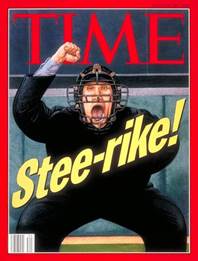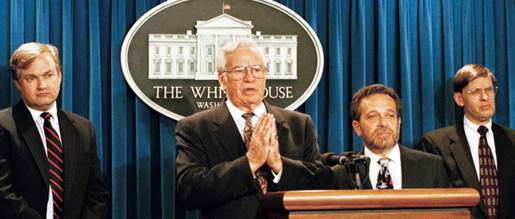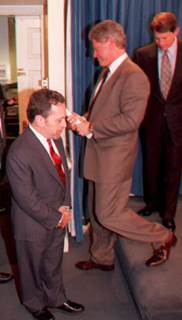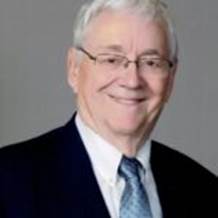It’s time for the annual Hot Stove spring training post. Pitchers and catchers were set to report on February 15. Position players on February 20. It would be time again to recite Dan Quisenberry’s poem on the “rituals of spring training,” and report on my friends at the games in Surprise, Arizona.
Not.
With the lockout in its 78th day and no baseball being played, I’ll instead go with some off-the-field stories. Federal Baseball Mediation – a story from the 1990s. Downtown Stadium – a story from the 1960s. Gambling – a story since baseball began.
Federal Baseball Mediation: I’m not going to discuss the big issues currently being negotiated for the Collective Bargaining Agreement (CBA). It makes my head hurt. But here is the summary: IT’S ABOUT THE MONEY.
What about mediation by the Federal Mediation and Conciliation Service? This was proposed by the owners on February 3, but was immediately rejected by the players. They likely remember how federal intervention worked out in 1994.
The owners and players started the 1994 season without a contract. The negotiations for a new CBA hit an impasse, prompting the players to go out on strike on August 12. The parties agreed to meet with the Federal Mediation and Conciliation Service, but it was a short-lived disaster that netted zero results. On September 14, Commissioner Bud Selig cancelled the balance of the season.

In October, President Bill Clinton asked Labor Secretary Robert Reich to arrange for a mediator to push for an agreement for the 1995 season. Reich announced that former Labor Secretary William Usery would be the mediator and said, “For the last two months, the sounds of silence have replaced the boys of summer. For the first time since 1904, there will be no World Series. But now – maybe, just maybe – fall is bringing some hope.” Not.
Below at the podium, Usery (the taller one) and Reich. At the far left is Don Fehr, executive director of the MLB Players Association. On the right, Commissioner Selig. The body language and facial expressions of Fehr and Selig perfectly capture how this mediation played out.

The mediation struggled into February of 1995. As recounted by Robert Reich in his blog last week, President Clinton decided his personal touch might spur the negotiations:
“Bill was eager to get involved. He smelled a deal. He wanted to be savior of the national pastime. He had heard that the two sides were in Washington. ‘Why don’t we just call them over to the White House and see how far we can get.’ Hours later, Bill, Al Gore, and I were in the Roosevelt Room with Bud Selig…Don Fehr…and the other owners and players from the bargaining committees…the White House press room was crowded with reporters and cameras, anticipating a story of how the President settled the baseball strike.”
The initial formal meeting went nowhere, so smaller informal meetings began. Again from Reich:
“Bill and I went with Selig to another office. Bill sat down next to him on a couch, and commenced the move. Bill’s face was six inches away from Selig’s. Bill’s arm rested on the back of the couch behind Selig’s head so that his hand reached around to Selig’s other shoulder. It was full-intensity Bill Clinton. I was amazed Selig didn’t melt on the spot.”
After Selig left the meeting, Clinton told Reich, “I think we hit a homer.” More like a strikeout. When Selig came back with the owners’ response, it was “no deal.” After three hours of being nudged and charmed by the President, the parties left the White House as far apart as ever. The chastened President sadly announced the decision to the White House press corps. Below, Robert Reich (left), as Clinton and Gore leave the stage of the press room.

The players believed the owners were negotiating in bad faith. This would keep any mediator, the President or anyone else, from completing a deal. The situation escalated when the owners announced their intention to start the season with replacement players. But before that could happen, the players won an initial round at the NLRB, and the case headed to court.
The judge assigned to the case was District Judge Sonia Sotomayor who had been appointed to the bench in 1992 by George H. W. Bush. Sotomayor issued an injunction against the owners, upholding the NLRB ruling that the owners had used unfair labor practices by unilaterally implementing a salary cap and eliminating salary arbitration. The parties were ordered to work under the expired CBA until a new one was signed. The season opened on April 25. A new CBA was not signed until December of 1996.
Sotomayor was elevated to the Court of Appeals in 1998 by President Clinton. In 2009, President Barack Obama nominated her to the Supreme Court, saying “Some say Judge Sotomayor saved baseball.” One of her supporters testifying at the Senate hearing was David Cone, a member of the player’s committee who had been at the White House for the failed Clinton negotiations.
Robert Reich’s article is intended as a cautionary tale for President Joe Biden and his Labor Secretary Marty Walsh. “My advice to Marty, as former labor secretary to the current one: Stay away from baseball. I wouldn’t touch another baseball labor dispute if Babe Ruth asked me in person.”
The tenor of the 2022 negotiations evokes images from 1994. For a good read on the current “Tin-eared MLB posturing,” see Vahe Gregorian’s article in yesterday’s KC Star. He notes that stances taken by MLB “make it hard to argue that MLB is bargaining in good faith. And it’s had that feel to it all along.” Vahe added in a tweet, “Baseball threatens to provide fresh evidence of how those who don’t remember the past could be condemned to repeat it.”
[Baseball has had a colorful history of labor issues. Curt Flood, Marvin Miller, the reserve clause, free agency, owner collusion, etc. For those interested, this history was described in detail in a 3-part Hot Stove series in 2018. Click here.]
Kansas City Downtown Stadium: The current talk about a new baseball stadium downtown brings back memories of the downtown stadium proposed back in 1965. Jackson County had commissioned a feasibility study for a multi-purpose stadium to be the new home of the Kansas City A’s (or their replacement) and the Kansas City Chiefs. The teams were playing in old Municipal Stadium at 22nd and Brooklyn.
The feasibility report imagined a domed multi-purpose stadium and a nearby arena for basketball and hockey. There were several multi-purpose stadiums being built around the country, most notably the Astrodome which opened in 1965. The location for the downtown version was in the area that now houses the Kauffman Center for the Performing Arts (instead of Kauffman Stadium).

The report included a second scenario placing the domed stadium at the intersection of I-70 and I-435 (the “Leeds Site”).

The county, led by Presiding Judge Charles Curry, elected to proceed with the Leeds Site. Why not downtown? After all, a new stadium might be a catalyst for the downtown community. The Leeds Site was a lower cost, although one rumor that circulated was that it was a boondoggle because Curry was favoring his Democratic donors who owned the land and would profit from the sale. There was also a threat that eastern Jackson County interests might not support a downtown KC location.
Whatever the reason, selection of the Leeds Site was fortuitous from a stadium design perspective. A later proposal by Denver architect Charles Deaton envisioned separate stadiums for football and baseball. Both could fit at the Leeds Site. The idea was embraced by the Chiefs who welcomed not working with cantankerous A’s owner Charlie Finley on a multi-purpose stadium. The county agreed and took the two-stadium proposal to the voters in June of 1967. It won with 68.9% of the vote. Below, the two-stadium concept with a rolling roof that was eliminated in the final design.

Some of this will sound familiar to Hot Stove readers. In April of 2019, I wrote a long piece titled “Thank You Charles Curry, Alex Petrovic and Charlie Wheeler – Harry S. Truman Sports Complex” (click here).
After I posted that Hot Stove, I got a call from Charlie Hart who had worked for Curry in those days. He noticed that I had not included the specific reason for the selection of the Leeds Site. Well, I didn’t know for sure, so I had not addressed the issue. For instance, I left out the rumor that Curry was favoring donors (which I in no way believed). Charlie confirmed that this was silly. He said the main landowners were Republicans, as was Dutton Brookfield who chaired the bipartisan Jackson County Sports Complex Authority established by the state to oversee any new stadiums.
Cost and the potential of objections from eastern Jackson County were no doubt relevant, but those might have been overcome with political horse-trading. One item could not be fixed by political compromise. Charlie Hart says the clincher was condemnation, the tool used by government to clear an area for works that serve a “public purpose.” Are stadiums a public purpose under the law? They clearly are now with the blessings of legislation and court decisions. But in the 1960s? I checked in with Hot Stove Public Purpose Editor Mike White who opined “Maybe not in 1967.”
Hart told me that the county was afraid of lawsuits that might slow down the building of the stadiums. The land for the downtown site was owned by a variety of industries, residents and businesses. A potential quagmire. And it would only take one of them to test the law. With Charlie Finley threatening to move the A’s, the county wanted to move quickly to offer a new stadium to keep the A’s or entice an expansion team. And the Chiefs were anxious – playing in Municipal Stadium was not the right venue for one of the best teams in pro football.
So rather than risk litigation over public purpose, the Leeds Site was the easy choice. Charlie said his source for this info was his old boss, Presiding Judge Charles Curry.
Charlie Hart – Political Insider: Charles Curry first won office as presiding judge in 1962 and was reelected in 1966. Curry was building a political organization, the Committee for County Progress (the CCP, occasionally referred to as Charles Curry’s Party). Charlie Hart became active in the CCP and helped Curry and his team win big in 1966, including victories for Alex Petrovic and Charlie Wheeler who joined Curry on the 3-judge county court. Below, Curry (middle) celebrating those victories with Alex Petrovic (left) and Charlie Wheeler.

The judges put several bond issues before the voters in 1967, including the stadiums, and they won victories not seen since Harry Truman was on the county court.
Charlie Hart served as a top aide to Curry at the county from 1967 to 1970 and was a major networking force for endorsements and fund raising for CCP candidates. My first foray into politics was joining the Young Democrats in 1967. The club worked closely with the CCP in 1968 with an emphasis on the Eastern Judge race where Alex Petrovic won reelection. Two of the members of the YD club were sisters Roz Webb and Pat Hininger. Roz worked for Curry’s county counselor. Pat ran Alex Petrovic’s office. It was not long before I met their fellow courthouse friend Charlie Hart. He and I were like-minded and enjoyed working together.
By the time Charles Curry left office in 1971, the CCP was in its next generation of leadership. The primary force became Jim Nutter, and Jim’s right-hand man for CCP politics became master strategist Charlie Hart. Charlie’s personality and laugh endeared him to everyone, even political opponents. During the 1970s, we worked on many campaigns together. By then, he was in the insurance and benefits business and became my life insurance guy in addition to friend and political ally.

Below, Charlie at a pool party hosted by Rita and me in the 1980s.

We both eventually drifted from active politics, but never lost touch. We loved talking about the old days in politics, and we took this to a delightful level when we started making annual pilgrimages to Sugar Creek to visit with Alex Petrovic. These started in about 2010 and continued until Alex died in 2015 at age 92. We were joined in these visits by Pat Hininger who adored her old boss.
Alex could still do hilarious impersonations of Curry, Wheeler and other politicos. He had a story for almost every candidate we worked with back in the 1960s and 1970s. On one visit to Sugar Creek, Charlie brought memorabilia from the CCP days, including Charles Curry’s campaign scrapbooks and the CCP incorporation papers (Charlie had been the lawyer filing the papers). Alex added them to the archives he was donating to the Jackson County Historical Society. Below, a photo of Pat and Alex from one of our visits.

Several years ago, Charlie and his wife Pam moved to Pennsylvania to be near their daughter Sally and their grandchildren. Last week, on February 9, Charlie turned 85 years old. I called his cell and left a happy birthday message on his voicemail. Called later that day, but again no answer. Same thing the next morning. That night, my phone showed a call coming in from Charlie’s cell phone. It was Pam delivering the sad news. Charlie had died on his 85th birthday. He had been in poor health, but Pam said he held on to get to their 50th wedding anniversary and then set the next goal of his 85th birthday. She said if the Chiefs had beaten Cincinnati, he would have held on for the Super Bowl. Obituary here.
For those who knew Charlie and desire to make a contribution in his memory, a good choice would be the Village Church Food Pantry (6641 Mission Road, Prairie Village, KS 66208). Charlie was a long-time volunteer at the pantry before he left Kansas City.
RIP my friend.

Sports Gambling: Fans have been gambling on sports since, well, forever. It was so prevalent in early baseball days that bookies sat in the stands openly taking bets. It was mostly illegal, but widespread. Players betting or being involved in throwing games was a common subject. The throwing of the 1919 World Series by the Black Sox was the most famous of scandals, but it was not an isolated incident. Betting, illegal or not, generates interest in sports. And although the sports establishment wants to avoid scandals, gambling is otherwise a marketing friend. People who have a monetary interest in the outcome of the game are more likely to attend or watch on TV – both of which increase revenues for the teams.

I like the Bob Costas story of how sports gambling has been pervasive and accepted. When Bob was a kid of 7 or 8, he knew his father made daily $500 bets on baseball games – a lot of money in the early ‘60s. Scores were not readily available in the pre-internet days, and so Bob was sent to fetch scores for his dad by going out to the car and picking up distant AM radio stations to listen to games. He then reported the scores to his dad. That’s how Bob first heard Mel Allen and Red Barber. He also learned about spreads and odds and put those to use as a teenager. In his own words:
“When I was 15-16 years old, I ran a bookie operation of my own in my high school. The way I was successful was I knew who rooted for the Giants, Jets, Mets and Yankees. And so, if their team was favored, I’d create a line that was way higher than it should have been, but they bet with their hearts – so they’d be giving more points than they should have been given. And if their team was the underdog, I’d set the line too low, so they’d be getting too few points compared to the line. But they bet based on what teams they rooted for, so I was coming out way ahead. And a lot of times on the same game, I would hit a middle, and both sides would have to pay me.”
When Bob’s dad found out, the high school bookie operation ended.

Bob’s activities are an example of “vigorish” (a/k/a the “vig” or the “juice”). The bookie is entitled to a cut (the vigorish) of the gambling dollars for brokering the wager (say 5-10%). The bookies set odds and spreads to achieve a balance of bets on each side of a game so they are not at risk on the outcome. The bettors win or lose, but the bookie always gets the vigorish.
The bulk of sports betting has historically been handled by illegal bookmaking operations. Only four states with pre-existing gambling laws were exempt from a 1992 federal law prohibiting states from authorizing sports betting. But when that law was struck down by the Supreme Court in 2018, the gates (betting windows) opened. More than 30 states now have legalized sports betting. But not Kansas and Missouri. Kansas is working on legislation. Missouri supporters are taking a two-track approach, hoping that legislation can be passed, but if not, filing a ballot initiative.
All pro sports teams in Missouri have joined in the effort for legalization. An article in the Kansas City Star quoted Adam Sachs, Chief Legal Officer of the Royals: “The priority now is legislation. We’re all about enhancing the fan experience. We know that we need to connect with all demographics in order to be an exciting sport and this is one way of engaging our fans in new and different ways.”
Legalization expands the pool of claimers to the vigorish, likely raising the share of betting dollars that do not go back to the winning gamblers. Consider: (i) The bookies will still get a share – sportsbooks, casinos, online sites, etc. (ii) The government – taxes on the wagering revenue. (iii) The teams who provide the foundation for the gambling. This could be in the form of “integrity fees” – a percentage of the bets to assure integrity, i.e., avoiding scandals (see steroids; sign stealing). Preferred access to stats for setting up different kinds of bets. TV ads mixed with sportscaster talk about the odds (a lot of this in last year’s World Series). (iv) And don’t forget the players who are often the source of prop bets, like will Salvy Perez hit a homer on a given night. I’m betting this is part of the current CBA negotiations.
The Chicago Cubs are building a two-story sportsbook building just outside Wrigley Field (planned structure shown below). The official bookie partner for the Cubs is DraftKings which will operate the sportsbook. The Washington Nationals are planning a similar operation adjacent to Nationals Park. Their exclusive digital gaming partner is BetMGM.

End the lockout. Let the games (and the betting) begin.
Angela Wasson-Hunt – Good Samaritan: Over the years, I often crossed paths with Angela Wasson-Hunt. She was a banker (I represented borrowers), civic activist (fellow Democrat and Bill Clinton’s cousin) and public servant (member of the KC Police Board and the Missouri Housing Development Corporation). She was an early subscriber to Hot Stove and became integral to a storyline arc in March and April of 2020. Below are excerpts from the three Hot Stoves.
Hot Stove #124 (3/20/20): This post covered our early days in the KC lockdown for Covid. I made this comment on Day 10 of the stay-at-home order:
Day 10 – March 26 (Thursday): We are quickly going through dishwasher pods and coffee beans.
Hot Stove #127 (4/20/20): As the lockdown continued, an anonymous person came to our rescue.
One special quarantine note: In a prior Hot Stove, I commented that isolated living was quickly diminishing our supplies of dishwasher pods and coffee beans. This apparently prompted a Hot Stove reader to leave two tubs of dishwasher pods at the entrance desk in our condo building lobby. No name was left, but we are told that our benefactor was a woman in a red car. So we ask, in rock ‘n’ roll vernacular, “Who Are You”? Click here.

A Phone Call (A few days after 4/20): The Good Samaritan called and admitted her good deed. She had read about our pods running low and had two old tubs that did not work with her dishwasher. She thought they might work for us (they did). She had one specific request: Please do not publicize her name. So I did not.
Hot Stove #128 (4/27/20): The dishwasher pod story led off the next post:
Dishwasher Pod update. The mystery has been solved. The woman in the red car who left us the two tubs of dishwasher pods has admitted to her good deed. But the admission was “off the record,” and so Hot Stove will not reveal the source.
Until now. Angela was the woman in the red car.
Angela died on January 31, leaving us way too early (65). Obituary here.

RIP Angela. Good Samaritan. Good Person. Good Soul.
Super Bowl Sunday (February 13): This past Sunday, the Rams won the Chiefless Super Bowl. In more important news (to me) from that day, William “Doc” Worley turned 80. We talked earlier in the week about him joining Carole King and me in the octogenarian club.
Each of these events offer a potential segue to Lonnie’s Jukebox. For the Super Bowl, it would be the half-time rap music sung by “old” rappers who gave us supposedly “nostalgia” rap. You know you are old when you are not familiar with what is being called nostalgia music. My other choice would be what classifies as nostalgia with Doc Worley – golden oldies. I’m going with Doc..
Lonnie’s Jukebox – Doc Worley Octogenarian Edition: In the late 1970s, my friend and fellow politico Ken Hill introduced me to Doc Worley and Doc’s partner Mike Russell (RIP). Ken was helping me market my law practice, and Doc and Mike were also involved in politics. It went well. They became good real estate clients. They founded the Kansas City Business Journal and expanded the concept to other cities. Doc, ever the serial entrepreneur, later owned a very successful environmental company. The “Doc” is from his early career as a veterinarian. Below, Doc and Mike’s cover photo from 1986.

Doc and I were both kids from Eastern Jackson County. I graduated from Van Horn in 1959 and Doc from Raytown in 1960. In yet another example of the small world of greater Kansas City, one of his fellow graduates in 1960 was Pat Hininger. Yes, the one in the photo above with Alex Petrovic. Below, Pat and Doc at their 30th high school reunion in 1990. Pat was no doubt the youngest in the class. She and her sister Roz both started early and also skipped a grade.

Roz was also at Raytown, graduating in 1958. Below, the dynamic duo Pat and Roz in their blue Young Democrat blazers. Circa 1970.

Now for some jukebox selections by our Raytown graduates from their high school days. Click on the song titles to listen.
Pat: “Kansas City” by Wilbert Harrison and “Jailhouse Rock” by Elvis Presley.
Roz: “April Love” by Pat Boone and “Queen Of the Hop” by Bobby Darin.
Doc: “Running Bear” by Johnny Preston and “Shout” by the Isley Brothers.
Bonus Cut: “Shout” by Otis Day and the Knights in the movie Animal House.
Go Raytown Bluejays!